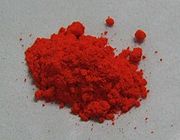
Rubrene
Encyclopedia
Rubrene is a red colored polycyclic aromatic hydrocarbon
. Rubrene is used as a sensitiser in chemoluminescence
and as a yellow light source in lightstick
s.
 As an organic semiconductor
As an organic semiconductor
, the major application of rubrene is in organic light-emitting diodes (OLEDs) and organic field-effect transistors, which are the core elements of flexible displays. Single-crystal transistors can be prepared using crystalline rubrene, which is grown in a modified zone furnace on a temperature gradient. This technique, known as physical vapor transport, was introduced in 1998.
Rubrene holds the distinction of being the organic semiconductor with the highest carrier mobility, which reaches 40 cm2/(V·s) for holes
. This value was measured in OFETs prepared by peeling a thin layer of single-crystalline rubrene and transferring to a Si/SiO2 substrate.
interactions, namely π-stacking and quadrupolar interactions. Owing to these weak interactions,
different growth conditions can lead to different crystalline structures – a phenomenon common to many organic crystals. Therefore, several polymorph
s of rubrene are known for crystals grown
from vapor in vacuum using sealed ampoules, including a monoclinic, triclinic and orthorhombic (space group Aba2) forms. Another orthorhombic form (space group Bbam) is known in crystals obtained in a closed system, in a two-zone furnace, at ambient pressure.
Polycyclic aromatic hydrocarbon
Polycyclic aromatic hydrocarbons , also known as poly-aromatic hydrocarbons or polynuclear aromatic hydrocarbons, are potent atmospheric pollutants that consist of fused aromatic rings and do not contain heteroatoms or carry substituents. Naphthalene is the simplest example of a PAH...
. Rubrene is used as a sensitiser in chemoluminescence
Chemoluminescence
Chemiluminescence is the emission of light with limited emission of heat , as the result of a chemical reaction...
and as a yellow light source in lightstick
Lightstick
A glow stick is a single-use translucent plastic tube containing isolated substances which when combined make light through a chemical reaction-induced chemiluminescence which does not require an electrical power source...
s.

Organic semiconductor
An organic semiconductor is an organic material with semiconductor properties. Single molecules, short chain and organic polymers can be semiconductive. Semiconducting small molecules include the polycyclic aromatic compounds pentacene, anthracene, and rubrene...
, the major application of rubrene is in organic light-emitting diodes (OLEDs) and organic field-effect transistors, which are the core elements of flexible displays. Single-crystal transistors can be prepared using crystalline rubrene, which is grown in a modified zone furnace on a temperature gradient. This technique, known as physical vapor transport, was introduced in 1998.
Rubrene holds the distinction of being the organic semiconductor with the highest carrier mobility, which reaches 40 cm2/(V·s) for holes
Electron hole
An electron hole is the conceptual and mathematical opposite of an electron, useful in the study of physics, chemistry, and electrical engineering. The concept describes the lack of an electron at a position where one could exist in an atom or atomic lattice...
. This value was measured in OFETs prepared by peeling a thin layer of single-crystalline rubrene and transferring to a Si/SiO2 substrate.
Crystal structure
Rubrene crystals are formed through competition between rather weak intermolecularinteractions, namely π-stacking and quadrupolar interactions. Owing to these weak interactions,
different growth conditions can lead to different crystalline structures – a phenomenon common to many organic crystals. Therefore, several polymorph
Polymorphism (materials science)
Polymorphism in materials science is the ability of a solid material to exist in more than one form or crystal structure. Polymorphism can potentially be found in any crystalline material including polymers, minerals, and metals, and is related to allotropy, which refers to chemical elements...
s of rubrene are known for crystals grown
from vapor in vacuum using sealed ampoules, including a monoclinic, triclinic and orthorhombic (space group Aba2) forms. Another orthorhombic form (space group Bbam) is known in crystals obtained in a closed system, in a two-zone furnace, at ambient pressure.

